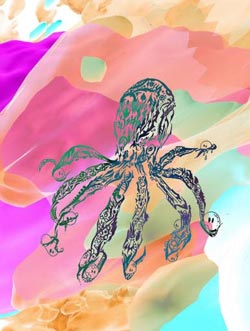Signal found to enhance survival of new brain cells

This is an illustration of parvalbumin-expressing interneurons delivering lifesaving chemical messengers to newborn neurons via tentacle-like synapses.<br><br>Credit: Mingxi Max Song and Gerald Sun<br>
A specialized type of brain cell that tamps down stem cell activity ironically, perhaps, encourages the survival of the stem cells' progeny, Johns Hopkins researchers report. Understanding how these new brain cells “decide” whether to live or die and how to behave is of special interest because changes in their activity are linked to neurodegenerative diseases such as Alzheimer's, mental illness and aging.
“We've identified a critical mechanism for keeping newborn neurons, or new brain cells, alive,” says Hongjun Song, Ph.D., professor of neurology and director of Johns Hopkins Medicine's Institute for Cell Engineering's Stem Cell Program. “Not only can this help us understand the underlying causes of some diseases, it may also be a step toward overcoming barriers to therapeutic cell transplantation.”
Working with a group led by Guo-li Ming, M.D., Ph.D., a professor of neurology in the Institute for Cell Engineering, and other collaborators, Song's research team first reported last year that brain cells known as parvalbumin-expressing interneurons instruct nearby stem cells not to divide by releasing a chemical signal called GABA.
In their new study, as reported Nov. 10 online in Nature Neuroscience, Song and Ming wanted to find out how GABA from surrounding neurons affects the newborn neurons that stem cells produce. Many of these newborn neurons naturally die soon after their “birth,” Song says; if they do survive, the new cells migrate to a permanent home in the brain and forge connections called synapses with other cells.
To learn whether GABA is a factor in the newborn neurons' survival and behavior, the research team tagged newborn neurons from mouse brains with a fluorescent protein, then watched their response to GABA. “We didn't expect these immature neurons to form synapses, so we were surprised to see that they had built synapses from surrounding interneurons and that GABA was getting to them that way,” Song says. In the earlier study, the team had found that GABA was getting to the synapse-less stem cells by a less direct route, drifting across the spaces between cells.
To confirm the finding, the team engineered the interneurons to be either stimulated or suppressed by light. When stimulated, the cells would indeed activate nearby newborn neurons, the researchers found. They next tried the light-stimulation trick in live mice, and found that when the specialized interneurons were stimulated and gave off more GABA, the mice's newborn neurons survived in greater numbers than otherwise. This was in contrast to the response of the stem cells, which go dormant when they detect GABA.
“This appears to be a very efficient system for tuning the brain's response to its environment,” says Song. “When you have a high level of brain activity, you need more newborn neurons, and when you don't have high activity, you don't need newborn neurons, but you need to prepare yourself by keeping the stem cells active. It's all regulated by the same signal.”
Song notes that parvalbumin-expressing interneurons have been found by others to behave abnormally in neurodegenerative diseases such as Alzheimer's and mental illnesses such as schizophrenia. “Now we want to see what the role of these interneurons is in the newborn neurons' next steps: migrating to the right place and integrating into the existing circuitry,” he says. “That may be the key to their role in disease.” The team is also interested in investigating whether the GABA mechanism can be used to help keep transplanted cells alive without affecting other brain processes as a side effect.
Link to the article: http://www.nature.com/neuro/journal/vaop/ncurrent/full/nn.3572.html
Other authors on the study were Juan Song, Jiaqi Sun, Zhexing Wen, Gerald J. Sun, Derek Hsu, Chun Zhong, Heydar Davoudi and Kimberly M. Christian of Johns Hopkins, and Jonathan Moss and Nicolas Toni of the University of Lausanne in Switzerland.
The study was funded by the National Institute of Neurological Disorders and Stroke (grant numbers NS047344 and NS048271), the National Institute of Environmental Health Sciences (grant number ES021957), the National Institute of Child Health and Human Development (grant number HD069184), the Dr. Miriam and Sheldon G. Adelson Medical Research Foundation, the Brain and Behavior Research Foundation, the Maryland Stem Cell Research Fund, the Swiss National Science Foundation (grant number PP00A-119026/1) and the Fondation Leenaards.
Related stories:
Brain's Stem Cells 'Eavesdrop' to Find Out When to Act http://www.hopkinsmedicine.org/news/media/releases/brains_stem_cells
_eavesdrop_to_find_out_when_to_act
On Using Stem Cells in the Brain to Study Mental Disorders http://www.hopkinsmedicine.org/institute_cell_engineering/_includes/
videos/Transcriptions/Song_txn.html
Hopkins Researchers Uncover Key to Antidepressant Response http://www.hopkinsmedicine.org/news/media/releases/hopkins_researchers
_uncover_key_to_antidepressant_response
Media Contact
More Information:
http://www.jhmi.eduAll latest news from the category: Life Sciences and Chemistry
Articles and reports from the Life Sciences and chemistry area deal with applied and basic research into modern biology, chemistry and human medicine.
Valuable information can be found on a range of life sciences fields including bacteriology, biochemistry, bionics, bioinformatics, biophysics, biotechnology, genetics, geobotany, human biology, marine biology, microbiology, molecular biology, cellular biology, zoology, bioinorganic chemistry, microchemistry and environmental chemistry.
Newest articles

High-energy-density aqueous battery based on halogen multi-electron transfer
Traditional non-aqueous lithium-ion batteries have a high energy density, but their safety is compromised due to the flammable organic electrolytes they utilize. Aqueous batteries use water as the solvent for…

First-ever combined heart pump and pig kidney transplant
…gives new hope to patient with terminal illness. Surgeons at NYU Langone Health performed the first-ever combined mechanical heart pump and gene-edited pig kidney transplant surgery in a 54-year-old woman…

Biophysics: Testing how well biomarkers work
LMU researchers have developed a method to determine how reliably target proteins can be labeled using super-resolution fluorescence microscopy. Modern microscopy techniques make it possible to examine the inner workings…





















